You can help expand this article with text translated from the corresponding article in Serbian. (April 2016) Click [show] for important translation instructions.
|
The Metropolitanate of Dabar-Bosnia (Serbian: Митрополија дабробосанска / Mitropolija dabrobosanska) is a metropolis of the Serbian Orthodox Church in Bosnia and Herzegovina, seated in Sarajevo. Since 2017, Metropolitan of Dabar and Bosnia is Hrizostom Jević.[1]
Metropolitanate of Dabar-Bosnia Митрополија Дабробосанска | |
|---|---|
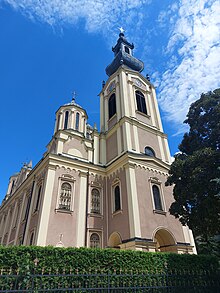 Cathedral of the Nativity of the Theotokos, Sarajevo | |
| Location | |
| Territory | Central region of Bosnia and Hercegovina |
| Headquarters | Sarajevo |
| Information | |
| Denomination | Eastern Orthodox |
| Sui iuris church | Serbian Orthodox Church Patriarchate of Peć (Serbia) |
| Established | 1219 |
| Cathedral | Cathedral of the Nativity of the Theotokos, Sarajevo |
| Language | Church Slavonic Serbian |
| Current leadership | |
| Bishop | Hrizostom Jević |
| Map | |
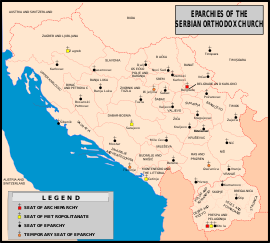 | |
| Website | |
| http://www.mitropolijadabrobosanska.org/ | |
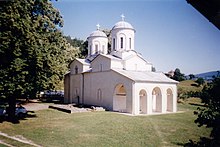
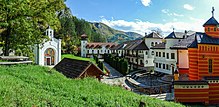
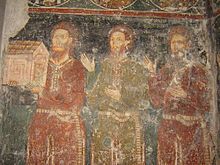

History
editThe medieval Eparchy of Dabar (Serbian: Дабарска епархија / Dabarska eparhija) was founded in 1219 by the first Serbian archbishop, Saint Sava. The seat of bishops of Dabar was in the Banja Monastery near Priboj. Eparchy of Dabar had jurisdiction over the region of lower Lim and middle Drina on the borders with medieval Bosnia.[2]
In 1557, Serbian Patriarchate of Peć was restored and the Eparchy of Dabar and Bosnia was returned to its jurisdiction, with its bishops of holding the honorary title of metropolitan.[3] In 1766, when the autocephalous Serbian Patriarchate of Peć was abolished, Eparchy of Dabar-Bosnia and all other Serbian eparchies under Ottoman rule came under the jurisdiction of Ecumenical Patriarchate of Constantinople. Bishop of Dabar-Bosnia kept his honorary title of metropolitan, as was also the custom in the Ecumenical Patriarchate. The seat of metropolitan was in Sarajevo.[4]
Since the 1878 campaign, Bosnia and Herzegovina was ruled by Austria-Hungary, but under the Convention of 1880 all Eastern Orthodox eparchies remained under ecclesiastical jurisdiction of Ecumenical Patriarchate of Constantinople. At the end of the First World War in 1918, all Eastern Orthodox bishops in Bosnia and Herzegovina reached a unanimous decision to join with other Serbian ecclesiastical provinces into united Serbian Orthodox Church. The process of unification was completed in 1920 and since then Eparchy of Dabar-Bosnia remains part of the united Serbian Orthodox Church.[5]
From 2015 to 2017, the diocese was administered by Bishop Grigorije (Durić) of Zahumlje and Herzegovina.[6]
Bishops
edit- Hristofor (13th c.)
- Joanikije (before 1292)
- Metodije (end of 13th c.)
- Nikola I (1284–1292)
- Jovan I (?)
- Spiridon (between 1286–1292)
- Isaija I (1281–1291)
- Jovan II (after 1286)
- Jovan III (after 1286)
- Isaija II (after 1286)
- Gavrilo (13th c.)[7]
- Jovan IV (1301–1317)
- Nikolaj II (after 1317–before 1328)
- Nikolaj III (before 1328-c. 1330)
- Marko (c. 1532)
- Varlam (c. 1557)
- Simeon (c. 1573)
- Nikanor (?)
- Josif (died 15 May 1575)[8]
- Gavrilo Avramović (1578–1588)[9]
- Petronije (1578–1589)[10]
- Aksentije (1589–1601)
- Teodor (1601–1619)
- Makarije (c. 1620)
- Isaija (1627–1635)
- Gavrilo Predojević (–1638)
- Isaija II (1640–1655)
- Longin (1656–1666)
- Hristofor Pivljanin (1666–1681)
- Atanasije Ljubojević (1681–1688)
- Visarion II (1690–1708)
- Isaija III (1708–1709)
- Mojsije Petrović (1709–1713)
- Meletije Umiljenović (1713–1740)
- Gavrilo Mihailović (1741–1752)
- Pajsije Lazarević (1752–1759)
- Vasilije Jovanović Brkić (1760–1763)
- Dionisije (1763?)
- Serafim (1753-after 1790)
- Danilo (c. 1769)
- Kirilo (1776–1779)
- Pajsije (before 1793–1802)
- Kalinik (1808–1816)
- Evgenije (1808?)
- Venijamin (1816–1835)
- Amvrosije Papa-Georgopolos (1835–1840)
- Ignjatije (1841–1851)
- Prokopije (1851–1856)
- Dionisije (1856–1860)
- Ignjatije II (1860–1868)
- Dionisije II Ilijević (1868–1871)
- Pajsije (1872–1874)
- Antim (1874–1880)
- Sava Kosanović (1881–1885)
- Bishop Georgije (Nikolajević) (1885–1896)
- Nikolaj Mandić (1896–1907)
- Evgenije Letica (1908–1920)
- Petar Zimonjić (1920–1941)
- Nektarije Krulj (1951–1966)
- Vladislav Mitrović (1967–1992)
- Nikolaj Mrđa (1992–2015)
- Grigorije Durić (2015–2017), administrator
- Hrizostom Jević (2017-present)
Annotations
editIt is known in English as the Metropolitanate of Dabar-Bosna[11] or Metropolitanate of Dabar-Bosnia.[12][6] It is scarcely known as the Metropolitanate of Dabar and Bosnia.[13] It was formerly unofficially known as the Metropolitanate of Sarajevo (Сарајевска митрополија).[14]
See also
editReferences
edit- ^ "Communique of the Holy Assembly of Bishops | Serbian Orthodox Church [Official web site]". www.spc.rs.
- ^ Јањић 2011, p. 133-148.
- ^ Sotirović 2011, pp. 143–169.
- ^ Kašić 1972, pp. 53–54.
- ^ Kiminas 2009, pp. 22, 28.
- ^ a b "Bishop Grigorije of Zahumlje-Herzegovina appointed Administrator of the Metropolitanate of Dabar-Bosnia | Serbian Orthodox Church [Official web site]". www.spc.rs.
- ^ Вуковић 1996, p. 97.
- ^ Вуковић 1996, p. 252.
- ^ Bataković, Dušan T. (1996). The Serbs of Bosnia & Herzegovina: History and Politics. ISBN 9782911527104.
- ^ Вуковић 1996, p. 406.
- ^ "Serbian Patriarch Irinej in the Metropolitanate of Dabar-Bosna | Serbian Orthodox Church [Official web site]". www.spc.rs.
- ^ "Metropolitan Nikolaj of Dabar-Bosnia reposes in the Lord | Serbian Orthodox Church [Official web site]". www.spc.rs.
- ^ Slobodan Mileusnić (1994). Medieval monasteries of Serbia. Prometej. p. 130. ISBN 9788676391479.
- ^ Поповић 1912, p. 624, 627.
Sources
edit- Поповић, Јевсевије (1912). Опћа црквена историја. Vol. 2. Сремски Карловци: Српска манастирска штампарија.
- Kašić, Dušan, ed. (1972). Serbian Orthodox Church: Its past and present. Vol. 3. Belgrade: Serbian Orthodox Church.
- Богдановић, Димитрије (1981). "Преображај српске цркве". Историја српског народа. Vol. књ. 1. Београд: Српска књижевна задруга. pp. 315–327.
- Јанковић, Марија (1985). Епископије и митрополије Српске цркве у средњем веку (Bishoprics and Metropolitanates of Serbian Church in Middle Ages). Београд: Историјски институт САНУ.
- Нилевић, Борис (1990). Српска православна црква у Босни и Херцеговини до обнове Пећке патријаршије 1557. године (Serbian Orthodox Church in Bosnia and Herzegovina before the renewal of the Patriarchate of Peć in 1557). Сарајево: Веселин Маслеша. ISBN 9788621004270.
- Вуковић, Сава (1996). Српски јерарси од деветог до двадесетог века (Serbian Hierarchs from the 9th to the 20th Century). Евро, Унирекс, Каленић.
- Bataković, Dušan T. (1996). The Serbs of Bosnia & Herzegovina: History and Politics. Dialogue Association. ISBN 9782911527104.
- Mileusnić, Slobodan (1997). Spiritual Genocide: A survey of destroyed, damaged and desecrated churches, monasteries and other church buildings during the war 1991-1995 (1997). Belgrade: Museum of the Serbian Orthodox Church.
- Radić, Radmila (1998). "Serbian Orthodox Church and the War in Bosnia and Herzegovina". Religion and the War in Bosnia. Atlanta: Scholars Press. pp. 160–182. ISBN 9780788504280.
- Popović, Svetlana (2002). "The Serbian Episcopal sees in the thirteenth century (Српска епископска седишта у XIII веку)". Старинар (51: 2001): 171–184.
- Ćirković, Sima (2004). The Serbs. Malden: Blackwell Publishing. ISBN 9781405142915.
- Радосављевић, Недељко (2007). Грађа за историју Сарајевске (Дабробосанске) митрополије 1836-1878 (Sources for the History of Sarajevo (Dabrobosanska) Archdiocese, 1836-1878). Београд: Историјски институт САНУ. ISBN 9788677430610.
- Радосављевић, Недељко (2009). Шест портрета православних митрополита 1766-1891 (Portraits of Six Orthodox Mitropolitans 1766-1891). Београд: Историјски институт САНУ. ISBN 9788677430788.
- Kiminas, Demetrius (2009). The Ecumenical Patriarchate: A History of Its Metropolitanates with Annotated Hierarch Catalogs. Wildside Press LLC. ISBN 9781434458766.
- Јањић, Драгана (2011). "Белешке о Дабарској епископији (Writings on the Dabar's Diocese)" (PDF). Баштина (31): 133–148.
- Sotirović, Vladislav B. (2011). "The Serbian Patriarchate of Peć in the Ottoman Empire: The First Phase (1557–94)". Serbian Studies: Journal of the North American Society for Serbian Studies. 25 (2): 143–169. doi:10.1353/ser.2011.0038. S2CID 143629322.